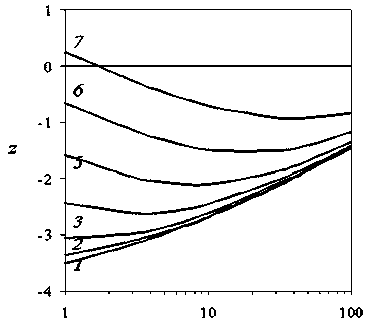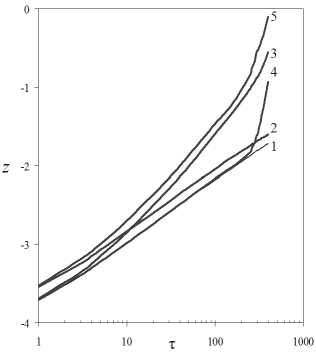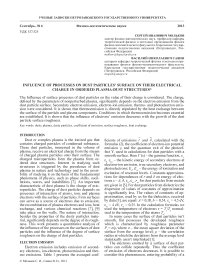Influence of processes on dust particles’ surface on their electrical charge in ordered plasma-dust structures
Автор: Molkov S.I., Savin V.N.
Журнал: Ученые записки Петрозаводского государственного университета @uchzap-petrsu
Рубрика: Физико-математические науки
Статья в выпуске: 6 (135), 2013 года.
Бесплатный доступ
The Influence of surface processes of dust particles on the value of their charge is considered. The charge, defined by the parameters of nonperturbed plasma, significantly depends on the electron emission from the dust particle surface. Secondary electron emission, electron-ion emission, thermo- and photoelectron emission were considered. It is shown that thermoemission is directly stipulated by the heat exchange between the surface of the particle and plasma components. Conditions in which thermoemission becomes essential are established. It is shown that the influence of electrons’ emission decreases with the growth of the dust particle surface roughness.
Dusty plasma, dusty particles, coefficient of emission, surface roughness, heat exchange
Короткий адрес: https://sciup.org/14750490
IDR: 14750490 | УДК: 537.525
Текст научной статьи Influence of processes on dust particles’ surface on their electrical charge in ordered plasma-dust structures
Dust or complex plasma is the ionized gas that contains charged particles of condensed substance. These dust particles, immersed in the volume of plasma, receive an electrical charge from the stream of charged plasma particles onto their surface. The charged microparticles form the plasma form ordered dust structures. Interest in studying such structures is triggered by the prevalence of dust plasma in nature and technology and in the possibility of studying it on the basis of the fundamental phenomena of physics, such as phase shifts, oscillations, waves, and instabilities [7]. An important characteristic of dust plasma is the charge of microparticles. The charge of dust particles depends on processes of interaction of atoms, ions and plasma electrons with the surface of particles. Firm surfaces can serve as a source of electrons due to emission; the recombination of plasma electrons and ions, heat exchange, and various chemical reactions [7], [9] take place on the walls. The nature of interaction, besides the properties of the dusty particles material, significantly depends on the degree of its roughness. This work presents a quantitative analysis of the influence of the processes on the surfaces of dust particles and the influence of the degree of surface roughness on the charge of dust particles.
ELECTRON EMISSION
Electron emission includes emission of secondary electrons, ion-electron, photoemission and thermo emissions. Table 1 presents the averaged coef- surface roughness, heat exchange ficients of emissions r and δ, calculated with the formulas (2), the coefficient of electron-ion potential emission γ, and the quantum exit of the photoeffect Y, used in calculations for dust particles with a smooth surface. Here Γ (х) – the gamma function, εγ, е8 еpe - the kinetic energy of secondary electrons at electron-ion emission, true secondary electrons, and photoelectrons; Ea, Eex – the energy of ionization and excitation of resonant levels. Constants approximations for dependences of r and δ on energy of electrons ε – А, b, εn, εm, rm for dust particles from metals are given in [5]. For dust particles from dielectrics the dispersion of values of constants of approximation is significantly less. The values of constants of approximation, used by us for the dielectrics, received by data [3], are equal: А = 0,18, b = 0,54, εn = 4,5 eV, εm = 4 eV, rm = 0,55. In the calculation formulas we used the temperature of electrons т = Te/Ta normalized to the temperature of the atoms Ta.
In many cases the surface of dust particles isn’t smooth, but possesses the developed roughness which is characterized by roughness parameter P s = a / p , where a - the mean square deviation of the surface from the average level; ρ – the сorrelation radius at which the deviations from the average level statistically aren’t interlinked [1].
The electrons emitted by a surface of dust particles can collide repeatedly. Thus the coefficient of emission of electrons decreases. It is possible to consider this phenomenon, entering probability of a
Expressions and the calculation formulas for the coefficients of emission and energy of secondary electrons
Table 1
Process
Emission coefficient
Calculation formula of coefficient of emission for dielectrics
Energy of secondary electrons, eV
Emission of elastic reflected electrons
Г Б" Т
1.24т
(4 + 0.026т)3
2 T e
Emission of real secondary electrons
5 = ЛГ(1 + ^1 + 6 + -|^ jr6 X

Electron-ion emission
Photo emission
Y


ε δ ~ 1 eV ~ T δ
= 0.22 (Ne+Al 2 O 3 )
W 0= 3.9 эВ (Al2O3)
~10-1 (He, Ne)
~10-2 (Ar, Kr, Xe)
ε γ ~ 0.5( E a – 2 W 0) ~ T γ
ε pe ~ 0.5( E ex – W 0) ~ T pl
departure of a particle from a rough surface without collisions Pf [4], [5]:
Pf = —arctg—;= f п ^2 JP s ’
Dependence Pf on Ps , calculated on a formula (1), well coordinated with experimental data on coefficients of emission from a rough surface [5].
HEAT EXCHANGE OF THE PLASMA COMPONENTS AND DUST PARTICLES
The heat exchange of heavy particles (atoms, ions) with the dusty particles surface is characterized by coefficient of accommodation equal to the ratio of energy transmitted by the particle to the wall during a collision to the maximal possible energy. For effective coefficients of accommodation of atoms and ions with the accounting of repeated collisions on a rough surface we have [4]:
а = “ ° а = “ ° (1 + °'5 Pf ) (2)
“a а° + Pf (1 -а°), “' а° + pf (1 -а°У where α0 = 2,4μ/ (1 + μ) 2– coefficients of accommodation for the unitaty dispersion of atoms on a lattice of firm spheres [1]; μ = ma/mW – the ratio of the gas particle mass to the mass of an atom of surface. The kinetic energy acquired by atom after collision with a dust particle heated to temperature TW, is equal to 2αa (TW – Ta), and kinetic energy lost by an ion is equal to αi (εiw – 2TW), where εiw – kinetic energy of an ion at collision with a particle surface.
INFLUENCE OF THE EMISSION OF ELECTRONS ON THE ELECTRIC CHARGE OF THE DUST PARTICLES
The charge of dust particles is determined by the equation of balance of charges, which taking into account the processes of emission of secondary and thermoelectrons looks like:
Ji = У "" Pf \]^=Кг +JJEKS +
+ yiK,+YJphKpE+JthKw^
where Ji , Je , Jph, Jth – the flux density of ions, electrons, resonan p t photons and thermoelectrons; κ – the factor defined below. The density of a stream of thermoelectrons is determined by the dust particle temperature, and for its definition the equation of balance of a charge has to be solved together with the equation of balance of energy:
Jа °-Е ^ ( Pff Ра ) + J th Pf KW ^ Tw + а() ° 0 Tw -
= Jl \_Ео + «, (£,W " ^TW ) " ^7^5 ] +
+ Je \2Te - P, (72Текг + S85k5 )] +
, where Ja – the density of a stream of atoms; σ0 – Stephan-Boltzmann constant; a0 – integrated absorptive ability of a dust particle (blackness degree [8]); Ta = T.- temperatures of atoms (ions).
The left part of equation in (4) includes terms that account for the cooling of the dust particle by the atoms, thermoelectrons and radiation, and the right part includes terms that account for the heating of the dust particle by the ions, electrons, resonant photons and cooling by the corresponding secondary electrons. Table 2 specifies the flux densities of particles and the energies transferred to the surface of the dust particle or from its surface that were used in our calculations.
Expressions Ji and Je for the flux density of particles also correspond to the approach of the limited orbital movement [7]. Here ma – masses of atoms (ions) of plasma-forming gas; φW – particle potential; e Δ φ – decrease in work function W0 due to Schottky’s effect; Qex and βi – a rate constant of excitation of resonant levels of the atoms which split sponta-
Table 2
Expressions and calculation formulas for flux densities and for energies of various types of particles
The factor κ, included in the equations (3) and (4), is equal to 1 at the negative charge of a dust particle ( q < 0) and is equal to exp {- еф ^ T } at the positive charge because electrons of emission experience additional delay. Temperature T takes values Te , Tδ , Tγ , Tpe for different types of electron emission represented in Table 1, and TW – for thermoelectrons.
From the comparative analysis of the terms of the equation (3) it follows that the influence of thermoemission needs to be considered, when . As an illustration of this statement, Fig. 1 presents the dependences of a charge z on the temperature of electrons τ at different values of surface particle temperature τW calculated according to (3) for the discharge in Ne with dust particles from Al2O3 (mW= 20,4 u, W0 = 3,9 eV). Beginning with some threshold value (τW = 5), the influence of thermoemission on the value of the particle charge becomes essential.
In cases when the influence of thermoemission is insignificant, the charge of a dust particle depends only on the temperature of electrons or at non-Maxwell EDF on the effective temperature of the distribution function «tail». Fig. 2 presents dependences z (τ) which take into account three types of emission at various degrees of roughness of the dust particle surface. With the growth of the degree of roughness, the influence of emission weakens, and dependence z (τ) comes nearer to the corresponding dependence for a smooth particle without accounting for emission.

т
Fig. 1. Calculated dependences of a charge of a smooth dust Particle on the normalized temperature of electrons at various values of the rated temperature of this Particle’s surface τ : 1,0 (1); 5,0 (2); 5,2 (3); 5,4 (4); 5,6 (5); 5,8 (6); 6,0 (7) w

Fig. 2. Calculated dependences of the dust particle charge on temperature of electrons at various values of the degree of roughness of its surface: 0 (1) – smooth; 0,08 (2); 0,8 (3); (4) – smooth particle without accounting for emission

Fig. 3. Calculated dependences of the smooth dust particle charge on the temperature of electrons. (1) without accounting for emission; (2) taking into account ion – electronic and photoemissions; (3) taking into account secondary emission of electrons; 4 – only thermoemission is considered; 5 – all types of emission are considered
As the analysis of the terms of the energy balance equation (4) shows, the heating of the dust particle is carried out, generally, by ions, and cooling – by radiation and by atoms. The influence of other processes is insignificant. The charge of dust particles in the presence of thermoemission besides the temperature of electrons depends also on the concentration of electrons and atoms. With the growth n0 the influence of thermoemission grows, and with the growth na it falls. Thus, at elevated pressures (p ~ 10 torr) the heating of the dust particles up to the temperatures at which thermoemission is essential does not occur. With the reduction of pressure (p ~ 0,1torr) and growth Te, starting at some threshold value, the influence of thermoemission becomes essential at small degrees of blackness (a0 ≤ 0,1) and rather high concentrations of the loaded particles in non perturbed plasma (n0 ~ 1010–1011 cm–3). Fig. 3 presents dependences z (τ) for different types of emission, including the thermoemission, received at the joint solution of the systems of equations (3) and (4). In cases when a0 is close to 1, the cooling with radiation becomes noticeable and the influence of thermoemission decreases.
CONCLUSIONS
Thus, the effects of electron emission are of essential influence on the value of the dust particle charge, leading in some cases to an essential reduction of the charge in absolute value (i. e., reduction in half and more, up to the change of the value of the charge (see Fig. 1, curve 7 corresponding to τ W = 6)). Thus, the emission of electrons, dependent on the parameters of nonpertutbed plasma, the material of microparticles and the type of their surface, must be taken into account in theoretical descriptions of the processes in dust plasma as well as in analyses of experimental data.
* Work is performed with support of the Ministry of Education and Science of the Russian Federation, Program «Scientific and Educational Community of Innovation Russia» through contracts № 14.B37.21.0755.
Mol’kov S. I., Karelian State Pedagogical Academy (Petrozavodsk, Russian Federation)
SavinV. N., Karelian State Pedagogical Academy (Petrozavodsk, Russian Federation)
INFLUENCE OF PROCESSES ON DUST PARTICLES’ SURFACE ON THEIR ELECTRICAL CHARGE IN ORDERED PLASMA-DUST STRUCTURES
Список литературы Influence of processes on dust particles’ surface on their electrical charge in ordered plasma-dust structures
- Баранцев Р. Г Взаимодействие газовс поверхностями. М.: Наука, 1975. 343 с.
- Биберман Л. М., Воробьев В. С., Якубов И. Т. Кинетика неравновесной низкотемпературной плазмы. М.: Наука, 1982. 376 с.
- Бронштейн И. М., Фрайман Б. С. Вторичная электронная эмиссия. М.: Наука, 1969. 408 с.
- Мольков С. И. Влияние шероховатой поверхности стенок разрядной камеры на работу газоразрядных лазеров//Сборник докладов 20-й международной конференции «Лазеры. Измерения. Информация». СПб.: Изд-во Политехнического ун-та, 2010. Т. 1. С. 14-25.
- Мольков С. И. Влияние процессов на стенках капилляра на параметры плазмы положительного столба разряда низкого давления//Ученые записки Петрозаводского государственного университета. Сер. «Естественныеи технические науки». 2012. № 2 (123). С. 88-95.
- Райзер Ю. П. Физика газового разряда. М.: Наука, 1992. 592 c.
- Фортов В. Е., Храпак A. Г., Храпак С. А., Молотков В. И., Петров О. Ф. Пылевая плазма//Успехи физических наук. 2004. № 5. С. 494-544.
- Kreith F., Black W. Z. Basic Heat Transfer. Moscow: Mir Publ., 1983. 512 p.
- Mol’kov S. I., Savin V. N. Influence of Electron Emission Processes on the Charge of Dust Particles in Ordered Plasmadust Structures//Contributed Papers of VII International Conference Plasma Physics and Plasma Technology. Minsk, Belarus, Sept. 17-21, 2012. Minsk: Publishing Kovcheg LTD, 2012. Vol. 2. P. 790-793.


